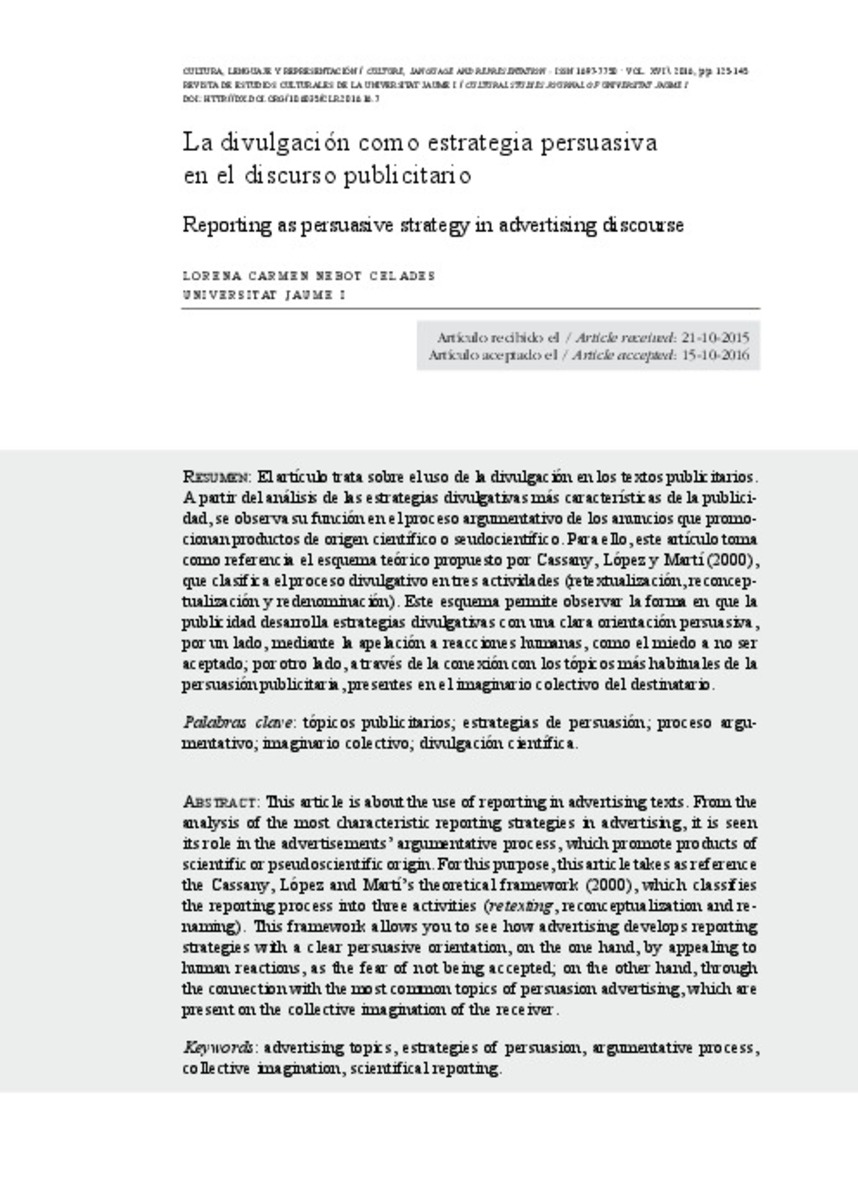Mostrar el registro sencillo del ítem
La divulgación como estrategia persuasiva en el discurso publicitario
| dc.contributor.author | Nebot Celades, Lorena Carmen | |
| dc.date.accessioned | 2017-02-17T08:50:54Z | |
| dc.date.available | 2017-02-17T08:50:54Z | |
| dc.date.issued | 2016 | |
| dc.identifier.citation | NEBOT CELADES, Lorena CarmeN. La divulgación como estrategia persuasiva en el discurso publicitario. Cultura, Lenguaje y Representación/Culture, Language and Representation, 2016, vol. 16, no 2, p. 125-145. | ca_CA |
| dc.identifier.issn | 1697-7750 | |
| dc.identifier.issn | 2340-4981 | |
| dc.identifier.uri | http://hdl.handle.net/10234/166118 | |
| dc.description.abstract | This article is about the use of reporting in advertising texts. From the analysis of the most characteristic reporting strategies in advertising, it is seen its role in the advertisements’ argumentative process, which promote products of scientific or pseudos cientific origin. For this purpose, this article takes as reference the Cassany, López and Martí’s theoretical framework (2000), which classifies the reporting process into three activities (retexting, reconceptualization and renaming). This framework allows you to see how advertising develops reporting strategies with a clear persuasive orientation, on the one hand, by appealing to human reactions, as the fear of not being accepted; on the other hand, through the connection with the most common topics of persuasion advertising, which are present on the collective imagination of the receiver. | ca_CA |
| dc.description.abstract | El artículo trata sobre el uso de la divulgación en los textos publicitarios. A partir del análisis de las estrategias divulgativas más características de la publicidad, se observa su función en el proceso argumentativo de los anuncios que promocionan productos de origen científico o seudocientífico. Para ello, este artículo toma como referencia el esquema teórico propuesto por Cassany, López y Martí (2000), que clasifica el proceso divulgativo en tres actividades (retextualización, reconceptualización y redenominación). Este esquema permite observar la forma en que la publicidad desarrolla estrategias divulgativas con una clara orientación persuasiva, por un lado, mediante la apelación a reacciones humanas, como el miedo a no ser aceptado; por otro lado, a través de la conexión con los tópicos más habituales de la persuasión publicitaria, presentes en el imaginario colectivo del destinatario. | ca_CA |
| dc.format.extent | 21 p. | ca_CA |
| dc.format.mimetype | application/pdf | ca_CA |
| dc.language.iso | spa | ca_CA |
| dc.publisher | Publicacions de la Universitat Jaume I | ca_CA |
| dc.relation.isPartOf | Cultura, Lenguaje y Representación, 2016, vol. 16, no 2 | ca_CA |
| dc.rights.uri | http://creativecommons.org/licenses/by-sa/4.0/ | * |
| dc.subject | tópicos publicitarios | ca_CA |
| dc.subject | estrategias de persuasión | ca_CA |
| dc.subject | proceso argumentativo | ca_CA |
| dc.subject | imaginario colectivo | ca_CA |
| dc.subject | divulgación científica | ca_CA |
| dc.subject | advertising topics | ca_CA |
| dc.subject | estrategies of persuasion | ca_CA |
| dc.subject | argumentative process | ca_CA |
| dc.subject | collective imagination | ca_CA |
| dc.subject | scientifical reporting | ca_CA |
| dc.title | La divulgación como estrategia persuasiva en el discurso publicitario | ca_CA |
| dc.title.alternative | Reporting as persuasive strategy in advertising discourse | ca_CA |
| dc.type | info:eu-repo/semantics/article | ca_CA |
| dc.identifier.doi | http://dx.doi.org/10.6035/clr.2016.16.7 | |
| dc.rights.accessRights | info:eu-repo/semantics/openAccess | ca_CA |
| dc.relation.publisherVersion | http://www.e-revistes.uji.es/index.php/clr/article/view/2290/1942 | ca_CA |
Ficheros en el ítem
Este ítem aparece en la(s) siguiente(s) colección(ones)
-
CLR_2016_núm.16 [10]








